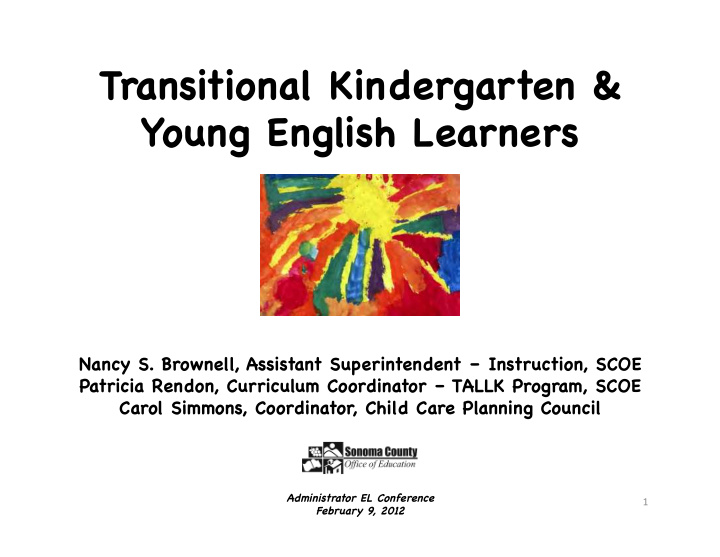



Transitional Kindergarten & Young English Learners Nancy S. Brownell, Assistant Superintendent – Instruction, SCOE Patricia Rendon, Curriculum Coordinator – TALLK Program, SCOE Carol Simmons, Coordinator, Child Care Planning Council Administrator EL Conference 1 February 9, 2012
Overview of SB 1381 • Kindergarten Readiness Act of 2010 (Simitian, Chapter 705, Statutes of 2010) • What did SB 1381 do? • Created funded Transitional Kindergarten (TK) classes to better prepare California’ s children for success in kindergarten and beyond. • Changed kindergarten entry date for a gradual implementation from age 5 by Dec. 2 to Sept. 1. 2
Overview of SB 1381 (cont.) • Kindergarten entry date change for five year olds phased in over three years – 2012-13: date moved back to Nov. 1 – 2013-14: date moved back to Oct. 1 – 2014-15: date moved back to Sept. 1 • Fully implemented by 2015 and ongoing 3
Governor’ s Proposal • Transitional Kindergarten now a district’ s choice • Kindergarten entry date change continues, with 3-year implementation • Governor estimates savings of $223 million for the state 4
In Light of Governor’ s Proposal… What do we know about the best principles and most effective practices for preschool and young English Learners’ success and literacy development in school? 5
Preschool English Learners Principles and Practices to Promote Language, Literacy, and Learning A Resource Guide Second Edition CALIFORNIA DEPARTMENT OF EDUCATION • SACRAMENTO, 2009 6
10 Principles for Promoting Language, Literacy, & Learning 1 1. Learning is enhanced for all when preschool programs and families form meaningful partnerships. 2. Children benefit when their teachers understand cultural differences in language use and incorporate them into the daily routine. 3. Successful practices promote shared experiences in which language is used as a meaningful tool to communicate interests, ideas, and emotions. 4. Language development and learning are promoted when preschool teachers and children creatively and interactively use language. 1 Preschool English Learners: Principles & Practices to Promote Language Literacy and Learning Resource Guide, CDE 7
10 Principles for Promoting Language, Literacy, & Learning 1 5. Experimenting with the use, form, purpose, and intent of the first and second languages leads to growth in acquiring the second language. 6. Continued use and development of the child’s home language will benefit the child as he or she acquires English. 7. Code switching is a normal part of language development for many bilingual children. 8. Coordination and collaboration among families, teachers, and specialists become crucial in supporting the language and literacy development of children with disabilities or other special needs. 1 Preschool English Learners: Principles & Practices to Promote Language Literacy and Learning Resource Guide, CDE 8
10 Principles for Promoting Language, Literacy, & Learning 1 9. Engaging in multiple literacy practices, such as reading books, singing songs, and reciting poetry, is part of the daily life of many families. Code switching is a normal part of language development for many bilingual children. 10. Offering a variety of opportunities for children to explore written materials and their meanings as well as the sounds of spoken language through rhyme and alliteration builds the language and literacy skills of preschool English learners. 1 Preschool English Learners: Principles & Practices to Promote Language Literacy and Learning Resource Guide, CDE 9
Review of Additional Materials Take a Look! Visual Supports for Learning (Paper Copy) • Teacher Support Strategies (Paper Copy) • Additional Strategies for Dual Language Learners (Paper Copy) • Storybook Reading for Young Dual Language Learners (Paper Copy, Excerpt Only) • “Extra Talk” Makes Kids Smarter! (Paper Copy) • SB Bill 1381 Author’ s Letter (Available on Flashdrive) • Video Samples (Available on Flashdrive) • 10
Thank You! 11
Recommend
More recommend